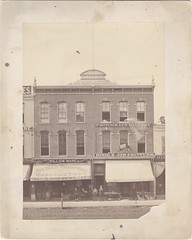.
This wonderful photo hollers to us from about 1881. Brought to my attention by a constant contributor to the American Book Trade Index, Mr. WS. Thanks!! This is one of several from 19th Century Detroit.
If you visit the image on the ABTI you can see it at a larger than life level to see it ain't books out on the table on the walk there. What follows is the info posted on the Detroit Public Library's website, where this info was found.
Antonio Dondero's wicker furniture factory
Three-story brick building, with "A. Dondero" on pediment. Men and boys stand by wicker furniture and baskets on sidewalk. Signs on building read: Detroit Willow Ware Manuf'ry, A. Dondero; photograph gallery; Willmen & Brookes, book & job printers. Brick buildings on both sides. Embossed on photograph front: "B.F.R.B. (?)." Handwritten on mat back: "North side Monroe Ave. bet. Farrer & Randolph, about 1881."
1 photographic print mounted on mat board ; image 8.25 x 6 in.
Reproduction of photograph from the Burton Historical Collection
Courtesy: Detroit Public Library
.
Friday, April 25, 2008
Saturday, April 19, 2008
UCO Book Sale Report
.
Last night I attended the 8th annual FOL sale benefiting the University of Central Oklahoma Library. I've visited the UCO campus a couple times before, and never the library. So I started in the visitor lot (mistake) and wondered around. There are no maps posted, so I relied on the kindness of students hanging around to point the library out. The Max Chambers library is in the Northwestern quarter of campus.
It was friends day, so I joined at the door. Membership levels start at $5, which is quite a bargain! Books were shelved along general topical lines. You know, environmental law in gardening, etc. I arrived at the end of the evening, long after the afternoon rush, so it was a little rummaged, but I still found some great books. There was a good mix of newer and older, hardback and paperback, ex-library and donated. Prices are very reasonable, and of course, go to a good cause. Follow the link at the top of the post for all the nitty-gritty.
Also, I found a flyaway for the record books. Flyaways are the stuff found in books. Usually postcards, receipts, etc. Well, this was nothing like that. The book published 1889, in cloth with a shaken spine and hinges starting. There seemed to be a good sized pebble or something in the spine. I tried to peek down the back strip-- something was down there alright, but I couldn't see what. I delicately prodded it with my Parker Jotter popping the invader loose. It clunked out on the shelf-- a chocolate chip. Whole and unsullied. Weird.
.
Last night I attended the 8th annual FOL sale benefiting the University of Central Oklahoma Library. I've visited the UCO campus a couple times before, and never the library. So I started in the visitor lot (mistake) and wondered around. There are no maps posted, so I relied on the kindness of students hanging around to point the library out. The Max Chambers library is in the Northwestern quarter of campus.
It was friends day, so I joined at the door. Membership levels start at $5, which is quite a bargain! Books were shelved along general topical lines. You know, environmental law in gardening, etc. I arrived at the end of the evening, long after the afternoon rush, so it was a little rummaged, but I still found some great books. There was a good mix of newer and older, hardback and paperback, ex-library and donated. Prices are very reasonable, and of course, go to a good cause. Follow the link at the top of the post for all the nitty-gritty.
Also, I found a flyaway for the record books. Flyaways are the stuff found in books. Usually postcards, receipts, etc. Well, this was nothing like that. The book published 1889, in cloth with a shaken spine and hinges starting. There seemed to be a good sized pebble or something in the spine. I tried to peek down the back strip-- something was down there alright, but I couldn't see what. I delicately prodded it with my Parker Jotter popping the invader loose. It clunked out on the shelf-- a chocolate chip. Whole and unsullied. Weird.
.
Monday, April 14, 2008
1873, Webster's Dictionary ad


.
On this day April 14th, 1828 Noah Webster published the first edition of his dictionary. Webster at the age of 70, Webster published his American Dictionary of the English Language in two quarto volumes (with pages 19 cm (7 in.) wide[1] and roughly 25cm (10in.) tall) containing 70,000 entries. According to Wikipedia he did. I honestly don't know a lot about Webster's dictionary. I have enjoyed accounts of Samuel Johnson's dictionary, and Simon Winchester's The Meaning of Everything, the story of the OED. I've included another image from the American Book Trade Index, this time an ad for Webster's dictionary from an 1873 New Hampshire Farmer's Almanac. The dictionary was offered for $12!
.
Tuesday, April 8, 2008
Book Shop Cats
.
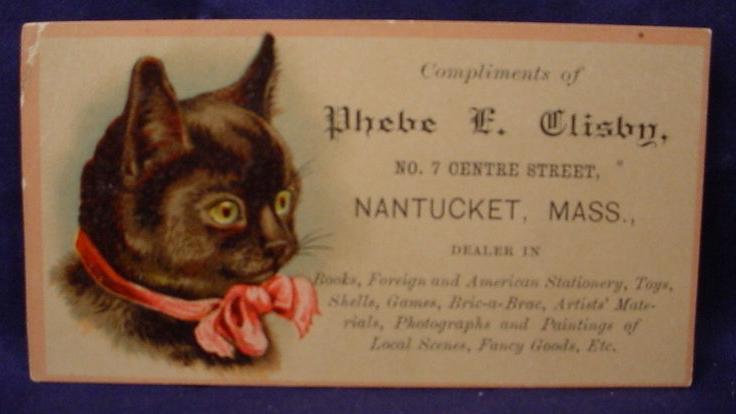 Why do all used book stores have cats? Don't tell me any reasons that explain how wonderful cats are. No. Cats are... well, they're a lot of things, but one thing for certain: they are not for me. People don't own cats, cats retain you for their staff.
Why do all used book stores have cats? Don't tell me any reasons that explain how wonderful cats are. No. Cats are... well, they're a lot of things, but one thing for certain: they are not for me. People don't own cats, cats retain you for their staff.
I think at least half of all used book stores have cats. Stores without feline tenants are over compensated for as it is rare to find a catty bookstore without several creatures within. So, my conservative estimate is that there are at least 3 bookselling cats for every used and antiquarian book shop in North America. If you think you can escape cats in books about bookshops, well the ratio in fiction is at least 12:1! Now, this is all based on years of extensive research and a dislike of cats.
Before the bibliocommunity starts heating up the tar and plucking chickens, I offer these: 19th century trade cards featuring cats. These cats aren't too bad. They're mostly cute, they don't shed, don't make a racket or *ahem* mark territory.
Since nearly all of my readers (well, both of you) are "cat people" I post the following for your viewing pleasure. Of course, these are only a few contributions to the American Book Trade Index, which churns on. We are currently closing in on the 1800 image mark! Hooray!
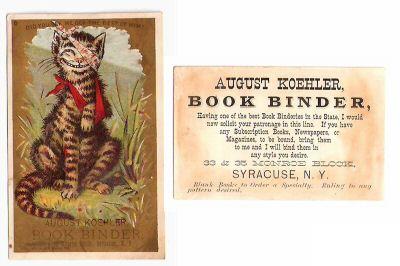
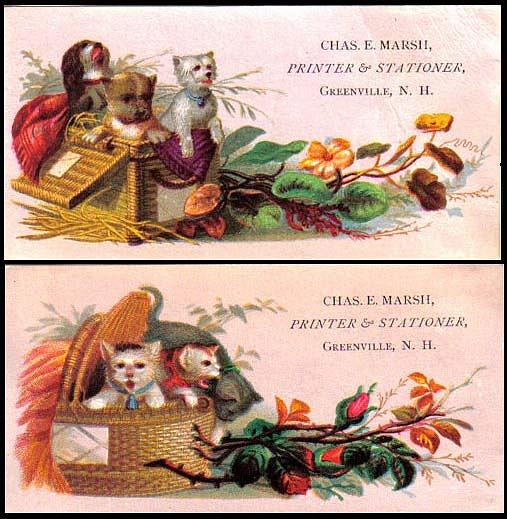
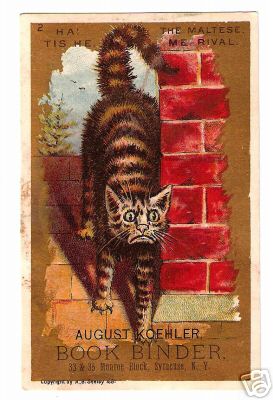
 Why do all used book stores have cats? Don't tell me any reasons that explain how wonderful cats are. No. Cats are... well, they're a lot of things, but one thing for certain: they are not for me. People don't own cats, cats retain you for their staff.
Why do all used book stores have cats? Don't tell me any reasons that explain how wonderful cats are. No. Cats are... well, they're a lot of things, but one thing for certain: they are not for me. People don't own cats, cats retain you for their staff.I think at least half of all used book stores have cats. Stores without feline tenants are over compensated for as it is rare to find a catty bookstore without several creatures within. So, my conservative estimate is that there are at least 3 bookselling cats for every used and antiquarian book shop in North America. If you think you can escape cats in books about bookshops, well the ratio in fiction is at least 12:1! Now, this is all based on years of extensive research and a dislike of cats.

Before the bibliocommunity starts heating up the tar and plucking chickens, I offer these: 19th century trade cards featuring cats. These cats aren't too bad. They're mostly cute, they don't shed, don't make a racket or *ahem* mark territory.
Since nearly all of my readers (well, both of you) are "cat people" I post the following for your viewing pleasure. Of course, these are only a few contributions to the American Book Trade Index, which churns on. We are currently closing in on the 1800 image mark! Hooray!



Subscribe to:
Posts (Atom)

